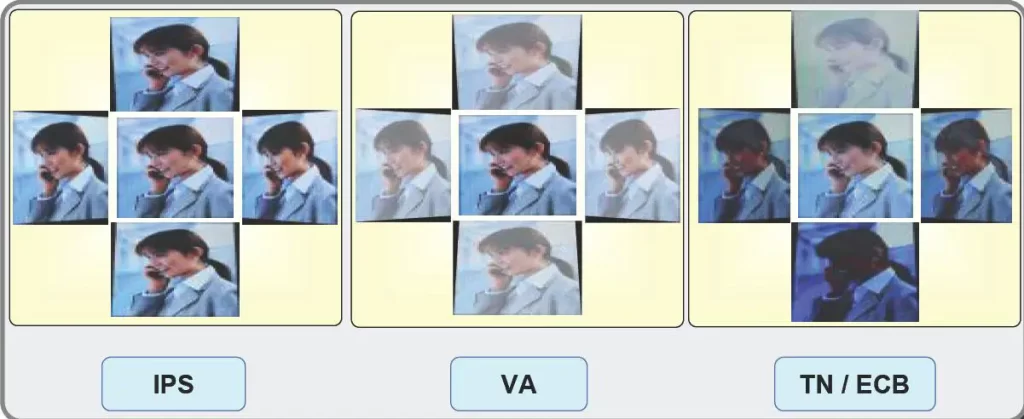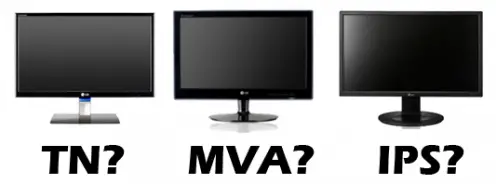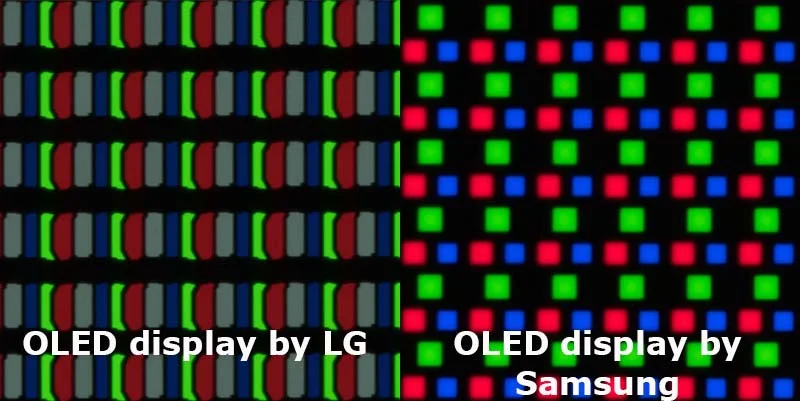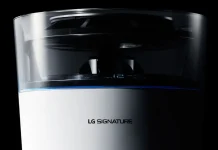How to understand the designation of displays for monitors, televisions, and monitors. Let’s take LED matrixes for TVs as an example: LED VA (SPVA)
- LED – is an LCD technology backlit by LEDs
- VA – manufacturing technology
- SPVA – a modification of the technology
Types of displays for TVs, monitors, phones
There are only four types of screens for televisions, monitors, and telephones:
Electron-beam tubes: an electro-vacuum device with a layer of phosphor. Under the influence of electrical impulses, an image would appear on it. I will not go into a description of the technology. There was a significant disadvantage in size and weight; all televisions and monitors had such screens until about 2005. Now it is an outdated technology.
Plasma panels: appeared in 2005; the screen consisted of cells filled with special gases, and gas began to shine under the influence of electric current. At that time, it was an advanced technology; it was possible to create flat, large screens; the drawback was the heavy weight and the gradual burn-out due to changes in the gas composition. Such screens were produced until 2014. Now it is also an obsolete technology.
LCD (LED) screens: These displays have been widely used since 2005 in televisions and monitors. A little earlier, such screens began to be used in telephones. The technology is based on the fact that there is a backlight layer and, in front of it, a matrix with pixels. The pixels are rotated in the cell; depending on the rotation angle, the light stream’s throughput changes, and the polarization of the crystal changes. Initially, the screen’s backlight was a lamp; in early 2010, lamps were replaced by LEDs; now, all screens are commonly referred to as LED, not LCD.
OLED displays: the newest technology, the first successful OLED TVs, appeared in 2017. Every year, more TVs, monitors, and phones have these screens.
In this article, I want to talk about the types of screens in more detail; for example, LED and OLED screens have several manufacturing technologies, and each technology has several modifications.
LED screen types
LED displays come in several types; they differ in manufacturing technology. This is important because it determines the quality of the image. Here is a summary of what is displayed by the technology of production.
- TN (Twisted Nematic) – one of the first displays and the worst in terms of parameters, installed in low-end devices. Currently not used in televisions.
- VA (Vertical Alignment) – the type of display is quite widely used; an advantage is a pretty good black color; the disadvantage is the slight change in contrast at angles, especially vertically.
- IPS (In-Plane Switching) – displays made with this technology have improved brightness and contrast but have the disadvantage of poor black color.
In the picture, you can see how the image quality of different types of panels will change.

TN (TN+film) panel
The first TFT panel, TN, is now commonly found in budget devices and frequently used as an interactive panel or in the industrial sector where high-quality color or large viewing angles are unnecessary. TN screens were initially produced, but a color filter was added to improve color, resulting in TN+film screens. Although all screens produced are now TN+film, they are still commonly referred to as TN due to habit. TN+film is rarely used in monitors and TVs because of poor picture quality.
Developers of IPS panel technology
IPS panels have been developed by various companies, resulting in many modifications. Although most displays today are made in China, it is essential to note that Chinese companies were not the creators of the technology. Instead, the screen manufacturing plants were built mainly in China because of cheap labor.
List of IPS technologies by the company
- IPS – in-plane switching (Hitachi)
- PLS – Plane to Line Switching (Samsung)
- AD-PLS – Advanced PLS (Samsung)
- S-IPS – Super IPS (NEC, LG.Display)
- E-IPS, AS-IPS – Enhanced and Advanced Super IPS (Hitachi)
- H-IPS – Horizontal IPS (LG.Display)
- e-IPS (LG.Display)
- UH-IPS и H2-IPS (LG.Display)
- S-IPS II (LG.Display)
- p-IPS – Performance IPS (NEC)
- AH-IPS – Advanced High Performance IPS (LG.Display)
- AHVA – Advanced Hyper-Viewing Angle (AU Optronics)
IPS panels and their modifications
- IPS – TFT screen technology, which was developed by Hitachi in 1996 as an alternative to TN displays, boasts wide viewing angles, deep blacks, and good color. However, one downside is its long response time, making it unsuitable for gaming.
- PLS – (Plane-к-Line Switching) Samsung, 4 ms response time (GTG). GTG (gray to gray) is the time to change a pixel’s brightness from minimum to maximum brightness. This modification of IPS had wider viewing angles without loss of brightness. The overall brightness of the display was also increased.
- AD-PLS – The same PLS panel, Samsung has slightly changed the production technology, as many experts say, it’s just advertising.
- S-IPS – Super IPS is a more advanced version of IPS technology that was developed to improve response time. It was designed specifically for use in monitors, which are often used for gaming and require quick response times.
- S-IPS II -the next generation of S – IPS panels, this version has reduced power consumption.
- E-IPS, AS-IPS – Improved and enhanced Super IPS, a development (Hitachi) – one of the improvements in IPS technology, this version has increased the brightness of the display and reduced response time.
- H-IPS – Horizontal IPS, (LG.Display) With this type of matrix the pixels are arranged horizontally. improved color reproduction and contrast. More than half of today’s IPS panels have pixels arranged horizontally.
- e-IPS – (LG.Display) Another improvement in production processes aimed at reducing production costs. Its disadvantage is a slightly smaller viewing angle, although for most viewers this is usually unnoticeable.
- UH-IPS and H2-IPS – Second generation H-IPS, increased brightness of the panel.
- p-IPS – It’s the same H-IPS, but developed by NEC.
- AH-IPS – modification for high resolution displays (UHD), analog of H-IPS.
- AHVA – Advanced Hyper-Viewing Angle is the designation given to displays by (AU Optronics), a company formed from the merger of Acer Display Technology and the screen manufacturing division of BenQ Corporation.
VA – Vertical Alignment panel
PVA – Patterned Vertical Alignment panel (Samsung)
PVA matrixes from Samsung have good contrast but have several drawbacks; the main drawback is the loss of contrast when viewing at an angle, especially vertically. But their main advantage is quite good black color compared to IPS.
The production technology of such screens has improved over time; you can meet modifications of the PVA displays.
- S-PVA – super PVA display with reduced power consumption, the second generation of PVA displays.
- cPVA – Simplified production technology in terms of image quality is worse than the S – PVA. Budget display for inexpensive devices.
- A-PVA – Advanced PVA has undergone absolutely no significant changes. Most likely marketing to better promote the monitors.
- SVA – The attempt to increase the number of display names produced is purely for marketing purposes. To explain many companies were developing displays at that time, and the displays themselves could not offer clear distinctions; in fact, there were no more than ten display factories. That’s when many names were invented, so the new model of monitor would stand out from the previous one.
Other VA panel manufacturers
TFT display technology (VA) was developed in 1996 by Fujitsu as an alternative to TN matrices. The screens produced with this technology at the time had disadvantages, such as longer response time and small viewing angles, but they had much better color performance. Nowadays, these displays have received many improvements; they have short response times and a high frequency of 144 Hz and higher.
- MVA – Multi Vertical Alignment (Fujitsu) A Fujitsu development that uses the Japanese corporation’s know-how. It has some differences in production compared to Samsung’s PVA.
- P-MVA (Premium MVA), S-MVA (Super MVA) – The next generation of MPVA displays has slightly improved color reproduction and contrast.
- AMVA –In the next generation of displays, engineers reduced the response time, as well as improved color reproduction.
QLED (quantum dot) displays
The leading developer of this technology was Samsung. But in 2022, the LED screen factories were sold to China’s TCL. Samsung decided to take up OLED technology. QLED is the same LED screen, usually made with VA technology. Such displays appeared in 2017, using standard production technology, but the materials from which the pixels are made are new.
The crystals (in the pixels) are made from high-purity materials. Have a luminous flux capacity of about 98% and good color rendering. As experts in the field of optics say, these are enlightened materials. Such screens have high brightness and realistic colors.
Because ultra-pure materials produce tiny crystals, the name “quantum dots” was coined. This is a purely commercial name that has nothing to do with the actual size of the crystal.
Currently, such screens are the top bar in LED displays. After all, they can display about a billion shades.
OLED (Organic Light Emitting Diode) Display
An organic light-emitting diode is a display developed using new technology. LED display requires the screen to be backlit from behind to create an image.
In OLEDs, the screen is made of organic LEDs, with each subpixel emitting light; they generate the light flux. There is no backlighting—advantages – brighter colors, perfect black. Disadvantages – the price of these screens, because of the complexity of production, burnout (organic LEDs lose brightness over time), and low brightness, or rather brightness, can be excellent. Still, it would help if you balanced the life of the display and its brightness.
Until 2022, LG was the only owner of big OLED TV screen technology. But since 2022, Samsung entered the market with its OLED displays; this is if we are talking about TVs. That’s why QD OLED displays came out.
OLED – each pixel is an LED, and LG has four sub-pixels in each pixel. Three main ones (green, red, blue) and an additional white to increase the picture’s brightness.
QD-OLED is a Samsung development, each sub-pixel is an organic LED, but one color and a film of quantum dot materials are placed in front of them to create the three primary colors. The QD-OLED panel has only three subpixels per image pixel. Therefore, Samsung increased the brightness of the image and made it commensurate with LED panels.








the visual perception of the same
Is AH-IPS better than PLS?